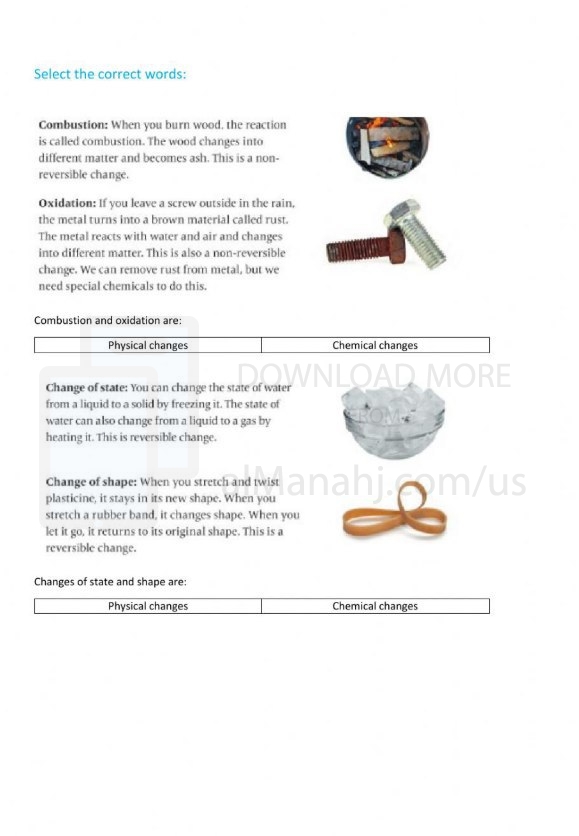| You are here: Almanahj Website ⇒ American curriculum ⇒ 5th Grade ⇒ Physics ⇒ Term 1 | ||
|---|---|---|
Worksheet about Physical and chemical changes and mixtures | ||
|---|---|---|
| Subject: Physics | ||
| 5th Grade | ||
| Term 1 | ||
| Year: 2023/2024 | ||
| Size: 224.5KB | ||
| Number of clicks: 110 | ||
| Publish date:November 10, 2023 | ||
| Added by: Eman | ||
| Last download date: 2024-09-12 12:59:19 | ||
| Updated by: Eman9966 on 2023-11-10 15:57:20 | By: theodor Cristina Conde de Felipe | |
| File info: Physical and chemical changes are two different types of changes that can occur in matter. Physical changes are changes that do not alter the identity of a substance. They are typically reversible, meaning that the substance can be returned to its original state. Examples of physical changes include: Changes in state: Melting, freezing, boiling, condensing, and sublimation are all physical changes that change the state of a substance without changing its identity. For example, water can exist as a solid, liquid, or gas, but it is still water in all three states. Dissolving: When a substance dissolves in a solvent, it forms a solution. This is a physical change because the identity of the substance is not altered. For example, salt dissolves in water to form a salt solution, but the salt is still salt. Mixing: When two or more substances are mixed together, they form a mixture. This is a physical change because the identities of the substances are not altered. For example, when oil and vinegar are mixed together, they form a vinaigrette, but the oil is still oil and the vinegar is still vinegar. Chemical changes are changes that produce new substances. They are typically irreversible, meaning that the original substances cannot be recovered. Examples of chemical changes include: Burning: When a substance burns, it reacts with oxygen to produce new substances, such as carbon dioxide and water. For example, when wood burns, it reacts with oxygen to produce carbon dioxide, water, and ash. Rusting: When iron reacts with oxygen and moisture, it rusts. Rust is a new substance that is different from iron. Digestion: When we eat food, our digestive system breaks it down into new substances that our bodies can use for energy. Cooking: When we cook food, we are causing chemical changes to occur. For example, when we cook eggs, the proteins in the eggs denature and form new substances. Mixtures are combinations of two or more substances that are not chemically combined. They can be either physical or chemical mixtures. Physical mixtures are mixtures in which the substances retain their individual identities. They can be separated using physical methods, such as filtration, distillation, or centrifugation. Examples of physical mixtures include: Salt water: Salt water is a physical mixture of salt and water. The salt and water can be separated using distillation. Oil and vinegar: Oil and vinegar are a physical mixture of oil and vinegar. The oil and vinegar can be separated using a separatory funnel. Air: Air is a physical mixture of gases, such as nitrogen, oxygen, and carbon dioxide. The gases in air can be separated using fractional distillation. Chemical mixtures are mixtures in which the substances have chemically combined to form a new substance. They cannot be separated using physical methods. Examples of chemical mixtures include: Brass: Brass is a chemical mixture of copper and zinc. The copper and zinc cannot be separated using physical methods. Steel: Steel is a chemical mixture of iron and carbon. The iron and carbon cannot be separated using physical methods. Water: Water is a chemical mixture of hydrogen and oxygen. The hydrogen and oxygen cannot be separated using physical methods. Physical and chemical changes and mixtures are important concepts in chemistry. They are used to understand how matter behaves and how it can be changed. | ||
| Downloading link Worksheet about Physical and chemical changes and mixtures |
|---|
|
1699601699.pdf
The file is being prepared for download
|
| File images |
|---|
 |